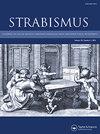{"title":"A study of the relative orientation of the extraocular rectus muscles: an advanced cadaveric approach.","authors":"Andrew T Barton, Viren K Rana, Eric J Kim, Surya Khatri, James Y Lee, Jamie Schaefer","doi":"10.1080/09273972.2024.2388076","DOIUrl":null,"url":null,"abstract":"<p><p><i>Purpose:</i> The anatomy of the extraocular rectus muscle insertions is clinically relevant in the field of ophthalmology. This descriptive cadaveric study determines the relative degree orientation of the superior, lateral, and inferior rectus muscles with respect to the medial rectus and investigates the distances between the rectus muscle insertions. <i>Method:</i> Thirty cadavers (50% female, mean age = 81.86 years, SD 12.16) were included for a total of 60 eyes. For each eye, a lateral canthotomy and cantholysis were performed followed by a peritomy. Muscle hooks were then used to access and isolate the rectus muscles. The degree orientation was determined by marking the muscle midpoints at insertion, using the center of the cornea as the vertex, and measuring the angle with the Angle Meter 360 application (© Alexey Kozlov) (Figure 1). The distances between rectus muscles were measured from the same muscle midpoints using calipers. <i>Results:</i> The degree orientations with respect to the medial rectus are displayed in Figure 2 and were as follows: superior rectus (mean = 93.14, SD = 3.04, min. 82.3, max. 100.3), lateral rectus (mean = 180.21, SD = 5.65, min. 170.5, max. 190.6), and inferior rectus (mean = 90.57, SD = 4.47, min. 84.0, max. 98.9). The distances (measured in mm) between rectus muscle midpoints at insertion included medial rectus to inferior rectus (mean = 13.64, SD = 0.54), inferior rectus to lateral rectus (mean = 13.79, SD = 0.75), lateral rectus to superior rectus (mean = 13.54, SD = 0.63), and superior rectus to medial rectus (mean = 13.83, SD = 0.75). The relative distances between the midpoints of the extraocular muscles observed in males versus females showed statistically significant differences in medial rectus to inferior rectus (13.8 vs. 13.5, <i>p</i> = .01), inferior rectus to lateral rectus (14.1 vs. 13.5, <i>p</i> = .03), and superior rectus to medial rectus (14.0 vs. 13.5, <i>p</i> = .04), respectively (Table 1). <i>Conclusion:</i> This is an important study of the extraocular muscle degree orientation performed with an innovative measuring approach. The degree orientation of the insertions relative to the medial rectus may have surgical application in the field of ophthalmology.</p>","PeriodicalId":51700,"journal":{"name":"Strabismus","volume":" ","pages":"54-57"},"PeriodicalIF":0.8000,"publicationDate":"2025-03-01","publicationTypes":"Journal Article","fieldsOfStudy":null,"isOpenAccess":false,"openAccessPdf":"","citationCount":"0","resultStr":null,"platform":"Semanticscholar","paperid":null,"PeriodicalName":"Strabismus","FirstCategoryId":"1085","ListUrlMain":"https://doi.org/10.1080/09273972.2024.2388076","RegionNum":0,"RegionCategory":null,"ArticlePicture":[],"TitleCN":null,"AbstractTextCN":null,"PMCID":null,"EPubDate":"2024/8/19 0:00:00","PubModel":"Epub","JCR":"Q4","JCRName":"OPHTHALMOLOGY","Score":null,"Total":0}
引用次数: 0
Abstract
Purpose: The anatomy of the extraocular rectus muscle insertions is clinically relevant in the field of ophthalmology. This descriptive cadaveric study determines the relative degree orientation of the superior, lateral, and inferior rectus muscles with respect to the medial rectus and investigates the distances between the rectus muscle insertions. Method: Thirty cadavers (50% female, mean age = 81.86 years, SD 12.16) were included for a total of 60 eyes. For each eye, a lateral canthotomy and cantholysis were performed followed by a peritomy. Muscle hooks were then used to access and isolate the rectus muscles. The degree orientation was determined by marking the muscle midpoints at insertion, using the center of the cornea as the vertex, and measuring the angle with the Angle Meter 360 application (© Alexey Kozlov) (Figure 1). The distances between rectus muscles were measured from the same muscle midpoints using calipers. Results: The degree orientations with respect to the medial rectus are displayed in Figure 2 and were as follows: superior rectus (mean = 93.14, SD = 3.04, min. 82.3, max. 100.3), lateral rectus (mean = 180.21, SD = 5.65, min. 170.5, max. 190.6), and inferior rectus (mean = 90.57, SD = 4.47, min. 84.0, max. 98.9). The distances (measured in mm) between rectus muscle midpoints at insertion included medial rectus to inferior rectus (mean = 13.64, SD = 0.54), inferior rectus to lateral rectus (mean = 13.79, SD = 0.75), lateral rectus to superior rectus (mean = 13.54, SD = 0.63), and superior rectus to medial rectus (mean = 13.83, SD = 0.75). The relative distances between the midpoints of the extraocular muscles observed in males versus females showed statistically significant differences in medial rectus to inferior rectus (13.8 vs. 13.5, p = .01), inferior rectus to lateral rectus (14.1 vs. 13.5, p = .03), and superior rectus to medial rectus (14.0 vs. 13.5, p = .04), respectively (Table 1). Conclusion: This is an important study of the extraocular muscle degree orientation performed with an innovative measuring approach. The degree orientation of the insertions relative to the medial rectus may have surgical application in the field of ophthalmology.


